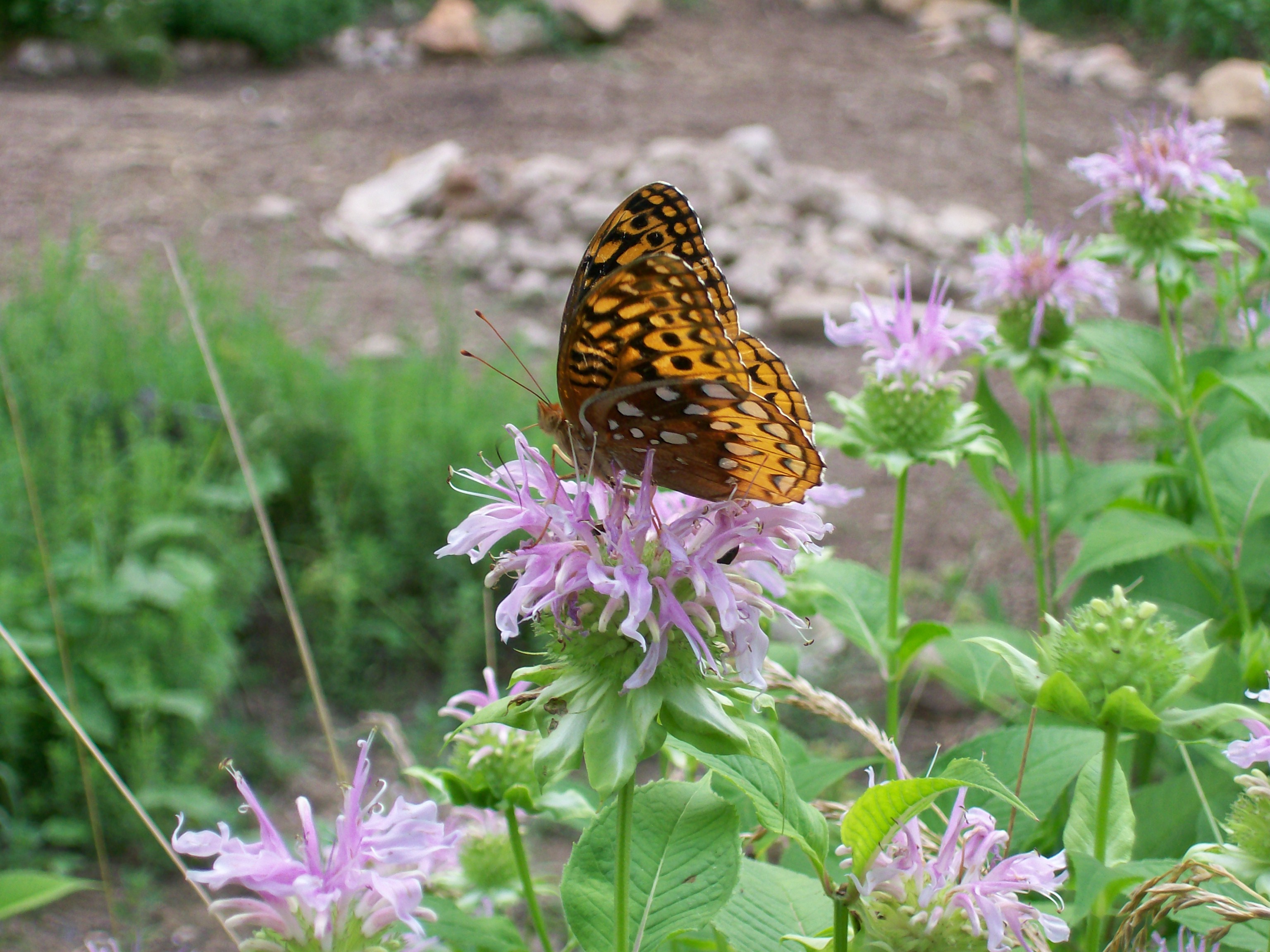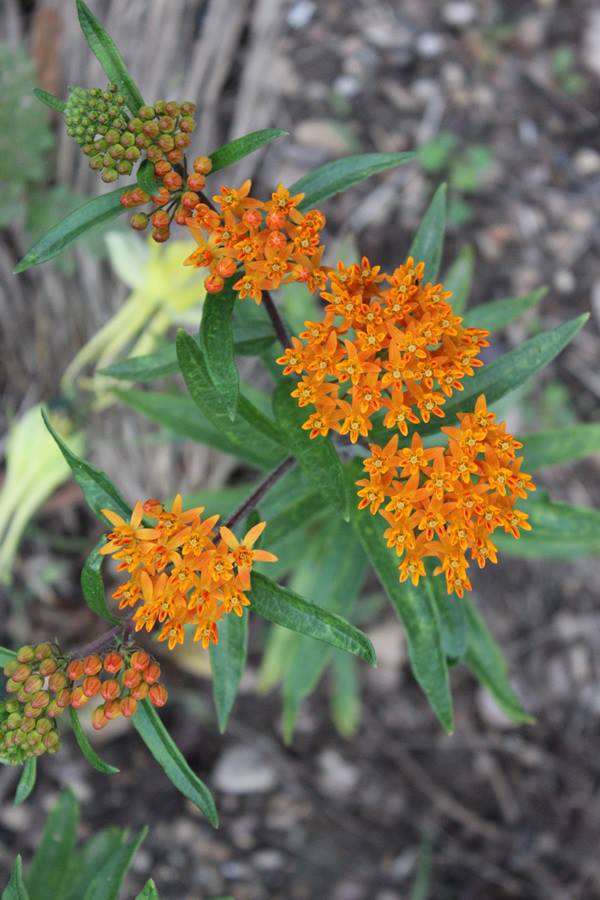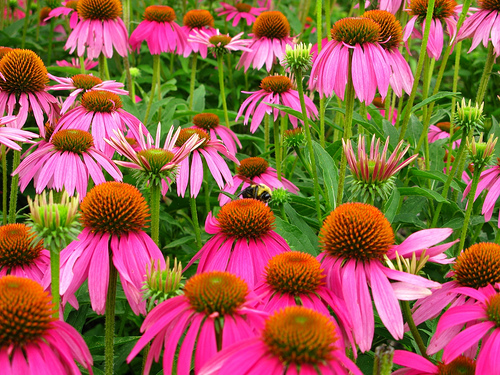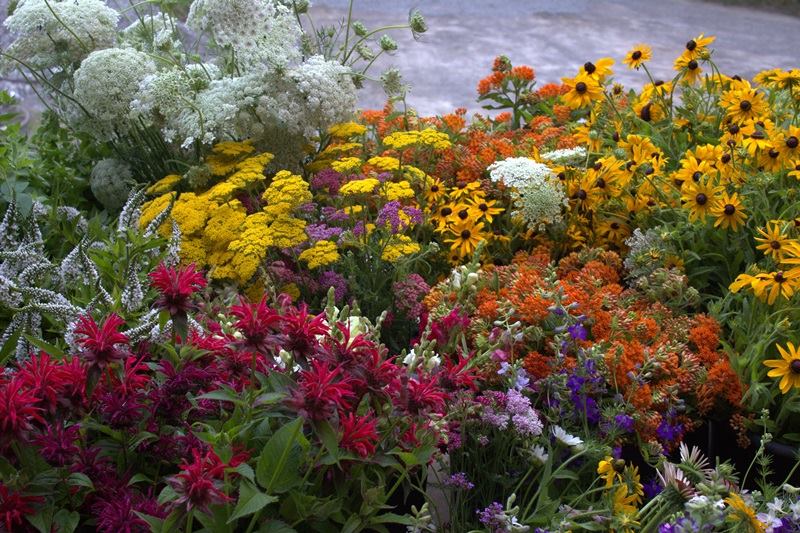By Jordan Charbonneau, photos by Southern Exposure Seed Exchange

Thankfully it seems people are coming around to the idea that our pollinators are in trouble. Wildflower packets and seeds bombs are “in” right now. While they may provide some relief, saving our precious bees, butterflies, moths, and other insects is going to take a little more than tossing a seed bomb into an empty garden bed.
Pollinators need food sources all season long from very early in the spring to late in the fall. In many areas native wildflower and meadow species have been replaced by monoculture lawns and select ornamental flowers. While this isn’t the only reason our pollinators are dying it certainly is a contributing factor. If you truly want to help pollinators it’s important to learn to plan a garden that offers an abundance of food sources all summer.
Timing
Figuring out how to have a garden that’s always in bloom can be a bit tricky. You’ll need to plan your plantings to maximize your garden’s potential.
Start Plants Early

For many hobby gardeners flowers get planted when all danger of frost is past. Unfortunately many pollinators are active early and need flowers as soon as it’s warm enough to move around. If you don’t start flowers ahead of time there won’t be any flowers when they need them most.
The easiest way to start flowers early is to start them indoors. The Southern Exposure Beginner’s Growing Guide is a great resource and can help you get a jump on the season.
Another great way to have early blooms is to plant perennial flower varieties like Butterfly Weed or self-seeding varieties. These are often sooner to bloom than the annuals.
Succession Planting
Some families may already practice succession planting in their home vegetable garden. Just like it’s better for families to have summer squash spread throughout the season than a ton all at once pollinators do better if you’re plants’ bloom times are staggered too.
To help pollinators with this problem it’s simple to start flowers in small batches, every two-four weeks depending on the variety so that they’re not all blooming at the same time. This can be done indoors in seedling trays or direct sowing in the garden.
For example single stem sunflowers generally only have pollen for about two weeks. To extend your harvest you can sow batches every two weeks. Just take into account your chosen variety’s “days to harvest” to ensure all of your plantings will bloom before fall frosts.
Selecting Varieties
Everyone has trouble picking out seeds. There’s so many varieties and so little time and space! For your pollinator garden there’s a few special considerations to help you narrow down your list.
Bloom Period
Typically flowers are selected for their looks and smell but for your pollinator garden you’ll want to consider when varieties flower, what time of day they flower, and how long they flower.
Some plant varieties offer much longer blooming periods than others. Often these varieties are favorites for cut flower growers but they can also be helpful for pollinators. Some great long blooming flowers include Cosmos, Zinnias, Bergamot, and Poppies.
Sadly moths are often forgotten in the pollinator conversation. Moths are beautiful and absolutely play a necessary part in the ecosystem. To give them a helping hand plant varieties like Four O’Clocks or Evening Scented Primrose which bloom in the evening.
Native Wildflowers
Another consideration when planting for pollinators is to be sure and include native species. Those free promotional wildflower seed packets are great but they may not include varieties that are essential to the survival of your local pollinators.
Native wildflowers are also well adapted to your local climate meaning that they can do well with much less watering and maintenance. They’re great for pollinators, the environment, and you! What’s not to love?
Some of my favorite native wildflowers from Southern Exposure include the Appalachian native Lemon Bergamot, the aptly named Butterfly Weed, and Texas native Red Drummond Phlox.
Dual Purpose Flowers

If you’re like me your garden is all about practically. While helping pollinators is obviously important to having a successful farm I still like to squeeze extra productivity where possible. I often pick varieties of flowers that are edible, medicinal, or can be used for dye. If you’re all about making the most of your garden space check out these varieties.
| Edible | Medicinal | Dye |
| Bachelor’s Button | Anise-Hyssop | Coreopsis |
| Bread Seed Poppy | Bergamot (Bee Balm) | Hopi Dye Sunflower |
| Grain Amaranth | Calendula | |
| Johnny-Jump-Up | Chamomile | |
| Mexican Mint Marigold | Echinacea | |
| Nasturtium | Feverfew | |
| Red Clover | Hyssop | |
| Sunflowers | Lavender |
Other Ideas
Aside from a carefully planned flower garden there are several ways to incorporate more blooms into your property.
Save Seed
You may think that plants like lettuce and radishes offer little benefits to pollinators because they’re harvested before they flower. However if you choose to save seed they’ll flower before you harvest your seeds.
Cover Crop
Never leave soil bare! Not only does it contribute to nutrient depletion and erosion it’s also a waste of valuable space. If you’re letting a section of garden rest for the season consider a cover crop like alfalfa or clover which fix nitrogen in your soil and flower for long periods. When you finish with an early crop like radishes, arugula, or peas consider quick to flower, cover crops like Buckwheat.
Leave Un-mowed Areas
If you have a larger property than you use for gardens a great way to help pollinators and many other native species is simply to leave areas natural. Without constant mowing many native species will flourish.
Sometimes all the world’s problems can be a bit overwhelming but small actions can really make a big difference. Following these tips can help you create a beautiful garden that will give pollinators a helping hand. With a little extra effort you’ll be helping moths, bees, butterflies, and other pollinators and beneficial insects.
What’s your favorite flower variety?

